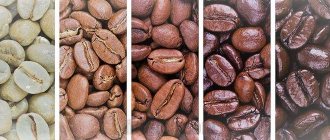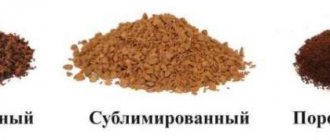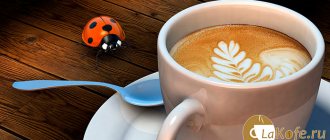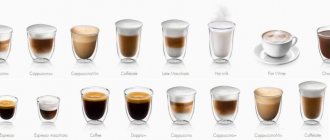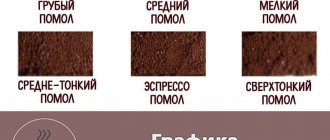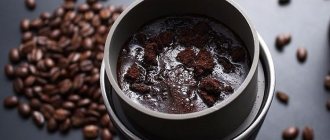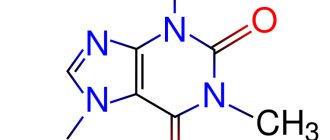Coffee is one of the most popular drinks in the world. It has an excellent taste and aroma, gives vigor and energy, and activates the brain. Modern consumer culture and industrial capabilities have changed the original type of coffee beyond recognition: many types and forms of the drink, preparation options, and additional ingredients have appeared.
Among such variety, you should carefully choose the type of coffee and preparation method in order to get the maximum benefit and avoid possible harm.
Soluble or natural?
Both instant and ground natural coffee are extremely common throughout the world and are in great demand. However, they have significant differences.
Soluble
Instant coffee is a drink made from coffee beans that have been processed to turn them into powder or granules that are soluble in water. The first stage of production is roasting the beans and subsequent grinding. The mixture is then poured with hot water and dried in various ways, which determine the type of instant coffee:
- Sublimated. The crushed grains are frozen and dehydrated in a vacuum environment. Freeze-dried coffee is distinguished by the preservation of almost all nutrients and high cost.
- Powder. The mixture is sprayed into a stream of hot air, then quickly dries and turns into powder. This option is the cheapest on the market and has a weak taste and aroma.
- Granulated. Made from coffee powder. The powder is moistened in water, then pressed until granules appear.
The main advantages of instant coffee are low cost and long shelf life.
Negative aspects - less pleasant (rich) taste and aroma, low caffeine content (2-3 times less than in a natural product).
But the main disadvantage of instant coffee is the high content of a toxic substance - acrylamide (about 2 times higher than in natural coffee). This substance can provoke the growth of malignant tumors (ovaries, endometrium), depress mental work, reduce fertility and increase the likelihood of early development of type II diabetes mellitus. American scientists came to these conclusions.
Natural
Natural coffee is a drink made from ground whole coffee beans. There are over 90 plant species growing in the world that belong to the genus Coffea, but only a few varieties are produced on an industrial scale:
- Arabica. The most common option (up to 90% in the world). The grains have an oblong shape and a smooth surface. During the roasting process, many unburnt areas remain due to the presence of an S-shaped groove.
- Robusta. It is characterized by a high caffeine content and a less pleasant aroma compared to other varieties. The share of world coffee is 5-7%. It is usually used not in pure form, but as mixtures, which makes the final drink cheaper. The grains have a round shape, without features.
The key stage in the production of natural coffee is roasting the beans. It is during this procedure that the beans acquire their characteristic brown color, the severity of which is determined by the degree of roasting. There are 4 degrees of roasting:
- light (Scandinavian);
- medium (Viennese);
- dark (French);
- very dark (Italian).
With a high degree of roasting, coffee beans lose valuable nutrients and also accumulate compounds that are toxic to the body, for example, acrylamide. However, the higher the degree of roasting, the brighter the taste and aroma. You should not overuse very dark varieties of coffee.
Scientists say that it is natural, freshly ground light and medium roast coffee that is most preferable for humans. See 14 beneficial properties of natural coffee here →
Comparison table
To understand which drink is healthier for a particular person, you should pay attention to the main differences between instant and ground (bean) coffee. They are presented in the table:
| Criterion | Soluble | Natural |
| Antioxidant content | Average | High |
| Taste and aroma | Less pronounced | More pronounced (proportional to the degree of roasting) |
| Caffeine concentration per 1 cup (170 ml) | 60-90 mg | 80-140 mg |
| Acrylamide concentration | 358 mcg/kg | 150-170 mcg/kg |
| Calories per 1 cup | 4 calories | 2 calories |
| Content of macro- and microelements per 1 cup (170 ml) | ||
| Calcium | 7.2 mg | 3.6 mg |
| Omega-6 fatty acids | 3.6 mg | 1.8 mg |
| Magnesium | 7.2 mg | 5.3 mg |
| Phosphorus | 5.4 mg | 5.3 mg |
| Potassium | 53.7 mg | 87.2 mg |
| Sodium | 7.2 mg | 3.6 mg |
| Caffeine | 46.5 mg | 71.2 mg |
Thus, it is recommended to give preference to natural coffee varieties that contain natural, technologically unaltered nutrients. It is important to note that natural coffee beans have a more pleasant taste and aroma, contain fewer toxic substances and have lower calorie content. Of all roast types, you should choose a low or medium level.
What is coffee
There are so many variations on the coffee theme that you can come up with: espresso, cappuccino, latte, frappuccino, affogato, Cuban, Vietnamese iced, Turkish, Irish, and also, as in the school cafeteria, it used to be called “from the bucket”, now it’s Americano. This is not a complete list of the names of coffee-based drinks, but we are not here to list them all. The point is that everyone likes their own coffee, but everyone wants to get a high-quality and healthy drink.
Coffee ranks second in the ranking of best-selling products. First - oil
First, let’s figure out which type of coffee is preferable in terms of quality and preservation of its main advantages.
Let's start with the fact that coffee, like any other plant, can be of different varieties. The most common of them are Arabica and Robusto.
There are 3 types of coffee on sale: beans, ground and instant. For some time now they have started selling green and unroasted coffee, but these are things for everyone and therefore are not widespread. In addition, experts say that it is impossible to roast coffee at the proper level at home, and therefore let everyone mind their own business.
First, let’s define the parameters by which we will find divine coffee for ourselves. We know that we are talking about the fruit of the coffee tree, collected, dried, roasted, then ground and brewed. Just business. However, each of the described stages will play a decisive role in what kind of drink will smoke in your cup.
Which cooking method is best?
As we have already found out above, natural coffee beans are the most preferable option. However, there are different methods of preparing the drink, which have their own disadvantages and advantages.
The following cooking methods are distinguished:
- "Turkish way" (in Turk). Turk is a utensil for making coffee. Usually, for this option, the finest grinding of grains is used, from which the taste and aroma have time to partially “come out.”
- French press. It is a device in the form of a cylinder with a piston-filter. Ground coffee is poured into a flask, filled with hot water (about 70-90 degrees) and infused for 5 minutes. Then the piston is lowered and the drink is poured into glasses.
- Filter coffee. It is done using various filters (most often paper). Ground coffee is poured into the filter and filled with hot water. The drink seeps through the pores and pours into cups.
- Geyser coffee maker. In the device, coffee is poured into one of the compartments, water is poured into the other, and it is installed on any heating surface (for example, on a gas stove). Steam under pressure passes through the compartment with ground coffee and is collected in the next container (with the finished drink).
- In a thermos. The principle is simple: ground grains are poured into a thermos, filled with hot water and left in this state for 1-3 hours.
- In the coffee machine. This device automates the coffee preparation process. Either ground or whole beans are loaded into the coffee machine (in this case, grinding occurs in the machine itself). The principle of operation is to pass hot water through a layer of ground coffee under pressure. Modern coffee machines have many additional built-in functions (milk frothing, etc.)
The most useful option for brewed coffee is “Turkish” (in Turk). During the preparation process, the drink retains the maximum amount of antioxidant substances and macroelements. The only drawback of boiled coffee is its less pleasant taste and aroma. It is important to consume the drink within the first 5-15 minutes from the moment it is ready, otherwise the totality of positive qualities will gradually be lost. Yesterday's coffee has a minimum of nutrients.
Exposure to a water temperature of less than 95 degrees (geyser coffee maker, French press) does not allow valuable components to escape from ground beans and is less useful.
Coffee from a thermos is the most undesirable option due to the long standing time.
There are many options for preparing an invigorating drink, the most useful of which is the “Turkish” method of preparation using Turks. It releases the maximum amount of nutrients from grains.
Conclusions:
- Ground coffee beans contain more than 300 vitamins, antioxidants, as well as potassium and magnesium, which are important for the heart and blood vessels. This is not the case with instant.
- Chemical preservatives and stabilizers in powdered or freeze-dried drinks can cause gastritis.
- Natural coffee contains 100% beans. In surrogates - about 15%, the rest are additives.
- The ground contains more cafestol, which in large quantities (more than 5 cups per day) can form atherosclerotic plaques. To get rid of cafestol, coffee is passed through a filter or prepared in a coffee machine.
- There is more caffeine in ground coffee, the difference is about 3.5 times.
Which coffee drink is healthier?
Many drinks are made based on coffee, the most popular of which are:
- "Espresso". It is prepared (usually in a coffee maker) exclusively from beans with the maximum degree of roasting. It has a low calorie content (7 calories). Served in 30-35 ml cups, it contains approximately 63 mg of caffeine. There are several classic variations: “lango” - diluted with water up to 55 ml, “Americano” - up to 150-160 ml, and “doppio” - double “expresso” (contains approximately 125 mg of caffeine).
- "Cappuccino". It is also produced on an espresso basis. Whipped milk is added to the drink (70-80% of the drink consists of milk). The caffeine content is similar to espresso. All ingredients are served warm in a cup with a volume of 150-190 ml. Energy value – 105 calories per 150 ml glass.
- Macchiato is a mixture of espresso and milk foam in a 1:1 ratio. Volume – 60-70 ml. Nutritional value: 66 calories.
- "Latte" . It is a milk drink. 75% is represented by milk. Served in transparent vessels with a volume of about 200 ml. Energy value – 112 calories.
- Moccacino is a coffee drink with the addition of chocolate, cocoa powder or chocolate syrup. Served in glasses with a volume of 200-250 ml. Contains about 270-320 calories.
Considering the characteristics of each drink, we can conclude that the most useful are “espresso” in its pure form and cappuccino. They are distinguished by sufficient caffeine content and low calorie content.
Calories and caffeine
Here are approximate figures: one teaspoon of soluble granules contains caffeine in the amount of 27 mg, crushed grains - 95 mg. According to the data, it is clear which coffee is best to drink to perk up.
Which coffee has less calories: a cup of ground coffee has about 5 calories, instant coffee has 2-3 calories. The difference is insignificant.
The answer to the question of which coffee is better to drink, ground or instant, is ambiguous. Any coffee becomes harmful if consumed in excess, but useful if you choose a high-quality product without “chemicals” produced by famous brands. The benefits and harms depend on how many cups you drink daily. The daily dose of a natural alkaloid should not exceed 400 mg.
Which supplements are best?
Traditionally, additional ingredients are added to coffee to give it a more refined taste and aroma, which allows you to enjoy the drink to the fullest. But not all supplements are created equal.
Below are the most popular supplement options and their effect on the body:
- Milk. Softens the bitterness of the drink, enriches it with additional antioxidants. Milk also helps maintain the integrity of the musculoskeletal system and prevent fractures, additionally reduces the risk of malignant neoplasms (colon and rectal cancer), reduces the likelihood of early cardiovascular mortality, and prevents the development of type II diabetes.
- Cream. Cream is the thick, fatty top layer of milk. They improve the taste, but significantly increase the energy value of the drink.
- Sugar. Allows you to reduce the bitterness of the invigorating drink. Belongs to the group of quickly digestible carbohydrates, which are extremely harmful to the heart and the entire body.
- Honey. For a long time it was believed that honey is an excellent alternative to “harmful” sugar, but recent scientific research completely refutes this information. It disrupts metabolism and increases the risk of heart attack and stroke due to its negative impact on the lipid profile.
- Lemon. Adds a special sour taste to the drink. Helps normalize the lipid profile (reduces total cholesterol and the concentration of low-density lipoproteins), prevents the development of cardiovascular diseases and their complications, and is especially effective in lowering blood pressure.
- Turmeric. Scientific research demonstrates that turmeric is beneficial for blood vessels and the heart, provides reliable prevention of atherosclerosis, type II diabetes, and improves the rheological properties of blood.
- Cinnamon. This spice inhibits the activity of pathogenic bacteria in the body, reduces the severity of inflammatory processes in the digestive tract, increases the sensitivity of peripheral tissues to insulin, reduces blood pressure (mainly the systolic component) and strengthens the immune system in general.
- Cardamom. It has general tonic properties and enhances the “invigorating” effect. Helps strengthen local and general immunity factors, slightly inhibits the effects of caffeine (recommended for strong coffee varieties).
- Carnation. The main advantages are a bright rich taste, lowering blood pressure and reducing blood viscosity. Recommended for people with pathologies of the blood coagulation system.
- Ginger. It increases the amount of lipoproteins with a high specific gravity, and reduces those with a low specific gravity, resulting in the prevention of atherosclerosis. Helps increase the activity of metabolic processes (useful for weight loss).
Coffee additives have different effects on the body. It is recommended to avoid adding honey or sugar. It is better to add lemon, turmeric, cinnamon, cardamom and ginger.
Let's sum it up
Is it better ground or instant? The first contains much more useful components and caffeine, respectively, freshly brewed espresso perfectly invigorates, fills with energy, and increases performance. It has a bright and unique flavor and aroma bouquet, but takes time to prepare for coffee drinking.
Instant coffee is inferior in these indicators, but has significant advantages - convenience, brewing speed and excellent taste. It can be chosen for hasty early morning awakenings and short breaks at work.
Special varieties
- Bulletproof coffee is a high-calorie product based on regular coffee, unsalted organic butter and MCT oils. Promotes weight loss by putting the body into “ketosis” mode and prolongs life in general.
- Decaffeinated coffee or “decaf” is a product from which almost all caffeine (up to 97%) is technologically removed. As a result, there is no effect of this biologically active substance, the list of contraindications for coffee is narrowed (acute inflammatory lesions of the digestive system, refractory arterial hypertension, etc.).
- Cold or iced coffee is a serving option in which the coffee drink is consumed cool, usually in the summer to quench thirst and improve performance. There are 2 main cooking options: diluting with cold milk or cooling.
There are “non-standard” options for drinks based on coffee beans, which are used for a highly specialized purpose. Their difference from “template” forms makes them unique, but they are not suitable for everyone.
Ground = all natural
The production of ground coffee begins with berry picking, processing and drying. Then the roasting and blending experts come into play. The final step is grinding the beans, packaging them in vacuum bags or cans. Thus, the ground contains only roasted crushed grains. At most, masters add flavorings to certain types of coffee - extracts obtained from processing plants and fruits. Ground coffee is 100 percent natural product.


